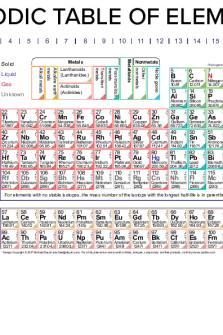M4 The Periodic Table - Lecture notes 6-8 PDF

| Title | M4 The Periodic Table - Lecture notes 6-8 |
|---|---|
| Author | Emma Jane |
| Course | Chemistry In Our World |
| Institution | Kent State University |
| Pages | 2 |
| File Size | 57.3 KB |
| File Type | |
| Total Downloads | 89 |
| Total Views | 129 |
Summary
Dr. F...
Description
Module 4: The Periodic Table Some Element Factoids Elements in their “elemental” form are neutral (#protons = #electrons) Most elements are NOT found in their “elemental” forms in nature When found in their “elemental” form, they are unlikely to be “pure” An element’s symbol can stand for: o The element itself o One atom of the element o A particular quantity of the element (mole) Mendeleev! 1869: Dimitri Mendeleev published the first systematic ordering of the elements known at the time with respect to both mass and chemical properties. Others had published similar systems around the same time, but only Mendeleev left deliberate blanks in his table AND predicted the properties of these missing elements The Periodic Table of the Elements Mendeleev: arranged the elements in increasing atomic weights o Saw repeating patterns of properties Modern: Elements arranged in order of increasing Atomic Number (#protons) o Repeating patterns of properties still there Rows are called “Periods” o Periods show regular variations in atomic and chemical properties. These properties repeat themselves row to row o The rows (or Periods) correspond to the main energy shells (n shells) Columns are called “Groups” o Elements in the same Group often show very similar chemical behavior. Groups are sometimes called “Chemical Families” Metals – Left Side of Table Most Elements are metallic o Past Uranium (92) are man-made Uses: LOTS! Non-metals: Right Side of Table (+ Hydrogen!) Only 17 non-metals H, C, N, O most important for life Semi-Metals Semi-Metals or Metalloids have properties intermediate between metals and nonmetals Most important here are the semiconductors: Si, Ge, and As Special Names for Special Groups Main Group or Representative Elements Groups 1, 2, 13-18 (A groups) o All non-metals o All semi-metals o Contains metals with predictable chemistry
Group 1(IA): Alkali Metals o Soft, silvery metals o Low densities o Excellent conductors o Highly reactive with air and water o Never found free in nature Lithium, sodium, potassium, rubidium, cesium, francium Group 2: Alkaline Earth Metals o Brittle, silver metals o Low densities o Excellent conductors o Heavier members are reactive with air and water o Never found free in nature Beryllium, magnesium, calcium, strontium, barium, radium Halogens: Group 17 (7A) o All exist as diatomic units as elements o All very reactive o Never found free in nature Fluorine, chlorine, bromine, iodine, astatine The Noble Gases: Group 18 (8A) o Very unreactive o Only heaviest (Kr, Xe) can be forced to make compounds o End each Period of the Table o Emit colored light when electrically excited – “neon lights” o Rn – radioactive; produced from uranium decay Helium, neon, argon, krypton, xenon, radon The Transition Metals Groups 3-13 (B groups) o Chemistry more varied and complex than Main Group metals o Known for forming highly colored complexes o Structural Metals: Ti, Fe, Ni, Cr, Mo o Coinage Metals: Cu, Ag, Au, (Pt) o Biological Importance: Fe – hemoglobin Many others – enzymes...
Similar Free PDFs

The Periodic Table
- 8 Pages

Navigating the periodic table
- 36 Pages

Periodic Table Summary Notes
- 11 Pages

Periodic table
- 2 Pages

Periodic-table
- 1 Pages

Periodic Table of the Elements
- 1 Pages

Periodic Table Virtual Lab
- 3 Pages

Periodic table worksheet
- 8 Pages

Iupac Periodic Table 2016
- 2 Pages

Alien Periodic Table
- 3 Pages

History of Periodic Table
- 1 Pages

Iupac Periodic Table
- 1 Pages
Popular Institutions
- Tinajero National High School - Annex
- Politeknik Caltex Riau
- Yokohama City University
- SGT University
- University of Al-Qadisiyah
- Divine Word College of Vigan
- Techniek College Rotterdam
- Universidade de Santiago
- Universiti Teknologi MARA Cawangan Johor Kampus Pasir Gudang
- Poltekkes Kemenkes Yogyakarta
- Baguio City National High School
- Colegio san marcos
- preparatoria uno
- Centro de Bachillerato Tecnológico Industrial y de Servicios No. 107
- Dalian Maritime University
- Quang Trung Secondary School
- Colegio Tecnológico en Informática
- Corporación Regional de Educación Superior
- Grupo CEDVA
- Dar Al Uloom University
- Centro de Estudios Preuniversitarios de la Universidad Nacional de Ingeniería
- 上智大学
- Aakash International School, Nuna Majara
- San Felipe Neri Catholic School
- Kang Chiao International School - New Taipei City
- Misamis Occidental National High School
- Institución Educativa Escuela Normal Juan Ladrilleros
- Kolehiyo ng Pantukan
- Batanes State College
- Instituto Continental
- Sekolah Menengah Kejuruan Kesehatan Kaltara (Tarakan)
- Colegio de La Inmaculada Concepcion - Cebu



